*This post may contain affiliate links. Read more »
These vegan gỏi cuốn, also known as Banh Trang Cuon, are probably the most well-known and loved incarnation of spring rolls all around the world. There. I said it, Cambodian and Thai versions cower to the simplicity, clean tastes and flavor of these Vietnamese salad rolls, and guess what else? They are DEAD SIMPLE and fast as heck to make, and are born to be dipped in peanut dipping sauce!


Enter your email & I'll send it to your inbox. Plus, get great new recipes from me every week!
By submitting this form, you consent to receive emails from Cinnamon Snail.
Why am I even calling them salad rolls? Well, Goi Cuon literally translates to just that. And for good reason, because these are fresh and filled with aromatic herbs, crunchy beansprouts, and all the greens and goodies you love. Perfect for serving with some bánh tráng trộn or veggie and seitan stuffed Bánh Bao Chay!
This recipe for Goi Cuon is here to guide you, whether you're a seasoned home cook or a novice in the world of Vietnamese cuisine. Are you ready to roll into a world of flavor, freshness, and pure delight? Damn right, you are! So let’s dive in!
Jump to:
🥰Why you'll adore this goi cuon recipe
✊ Vegan AF and GF: Like all of my Vietnamese recipes, this one is delicious without the need for animal products. It also just happens to be completely gluten-free too!
🍚 Vermicelli Magic: Have you ever had mushy, watery noodles falling out of your spring rolls? Don’t be a worldwide goof! Follow the easy soaking method outlined in my recipe instead of boiling, and you will have an easy time making these spring rolls perfect.
✅ Tested and Approved Worldwide: Like all of the recipes on my blog, I have made these fresh Vietnamese spring rolls a zillion times, and then I have shared the recipe with a crew of recipe testers from all over the world. You can trust it to work flawlessly, no matter where you are or what brands of ingredients you have.


🙌 Learn to make restaurant-quality Vietnamese food
This guide to my most popular vegan Vietnamese recipes is 100% FREE, & you'll love the actual heck out of it 🥰
🥬 Ingredients for banh trang cuon
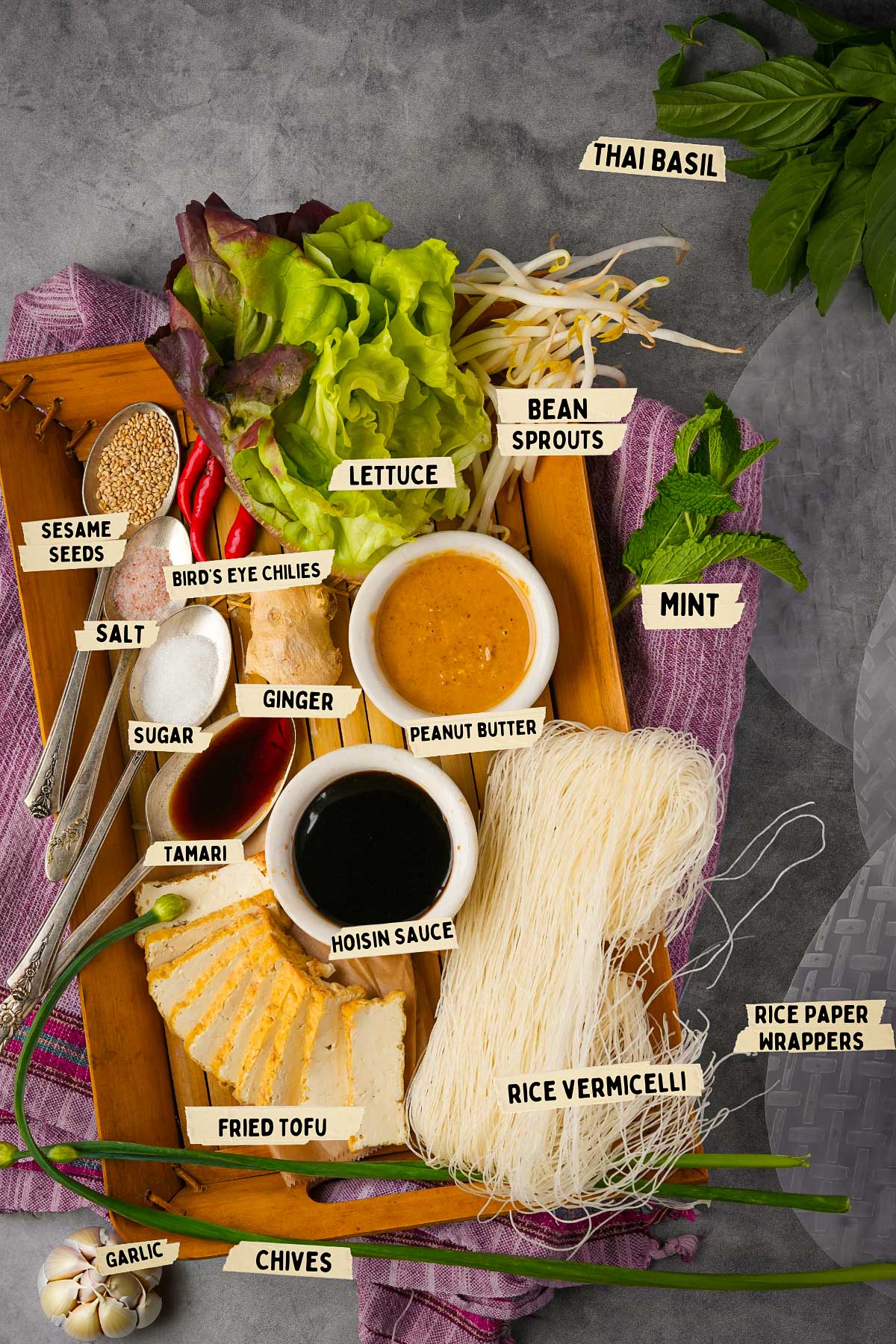
Rice Vermicelli Noodles
These slender rice noodles, which are the same ones you would stir-fry to make bihun goreng, are the backbone of Goi Cuon. They soak up flavors and provide a delightfully chewy texture. Substituting with thicker rice noodles or even glass noodles (what you would use to make pad woon sen) can work.
Fried Tofu (Dau Hu Chien)
If you start with pre-fried tofu that is cold, it is easier to slice, making these fast to put together. If you prefer, you can use blanched firm tofu, or substitute with soya chaap.
Fresh Herbs
Mint (Rau Hung Cay), Thai Basil (Rau Que), and Chives (He) are fragrant herbs that form the soul of banh trang cuon. You can substitute with cilantro, Vietnamese coriander, Italian sweet basil, or other fresh herbs if needed.
Bird's Eye Chilies (Ot Hiem)
Not everyone uses chilies in their banh cuon, but I am a little obsessed. I use these little red chilies (also often called Thai chilies) in everything from Tom Yum Paste to Khao Pad and sambals like dabu dabu and sambal matah. Be cautious if you're sensitive to heat though, as they're quite spicy. If you prefer a milder version, you can use jalapeños or omit them altogether.
Rice Paper Roll (Banh Trang)
These translucent circles are what hold all the goodness together. They soften in warm water and wrap around the filling like a delicate embrace. You can use brown rice papers too, but they tend to be smaller, which makes them harder to wrap. You will generally find the best range of sizes and brands at Asian grocery stores.
Hoisin Sauce
A luscious, sweet, and savory sauce that's the heart of the dipping sauce. It's made from fermented soybeans, garlic, and various spices. Definitely look for a plant-based brand, as some contain fish sauce or shrimp paste.
Peanut Butter (Bơ Đậu Phộng)
Smooth peanut butter adds creaminess and richness to the dipping sauce. It complements the spicy and sweet elements. Definitely go with a natural peanut butter without added sugars or palm oil. Raw almond butter or sunbutter (made from sunflower seeds) will work instead of peanut butter.
*See the recipe card at the bottom of the page for exact quantities, nutritional info, and detailed cooking directions.
🤯 Other gỏi cuốn recipes
Saigon Style banh trang cuon
In the southern city of Saigon, spring rolls made with pork belly or shrimp are common. For a vegan take on this Saigon classic, you can substitute Korean BBQ sauce grilled seitan or baked slices of king oyster mushrooms brushed with a little shatta sauce.
Goi Cuon Hanoi Style
In Hanoi, the capital of Vietnam, Goi Cuon is traditionally served with a sweet and tangy dipping sauce that includes fish sauce. I have a vegan version of this classic Nước Chấm dipping sauce on this website you can use in this Vietnamese peanut sauce recipe!
📖 How to make banh trang cuon
Nail this spring roll recipe on your first shot by following these step-by-step instructions with helpful tips. Or you can follow along with the easy-to-print recipe card towards the bottom of this page.
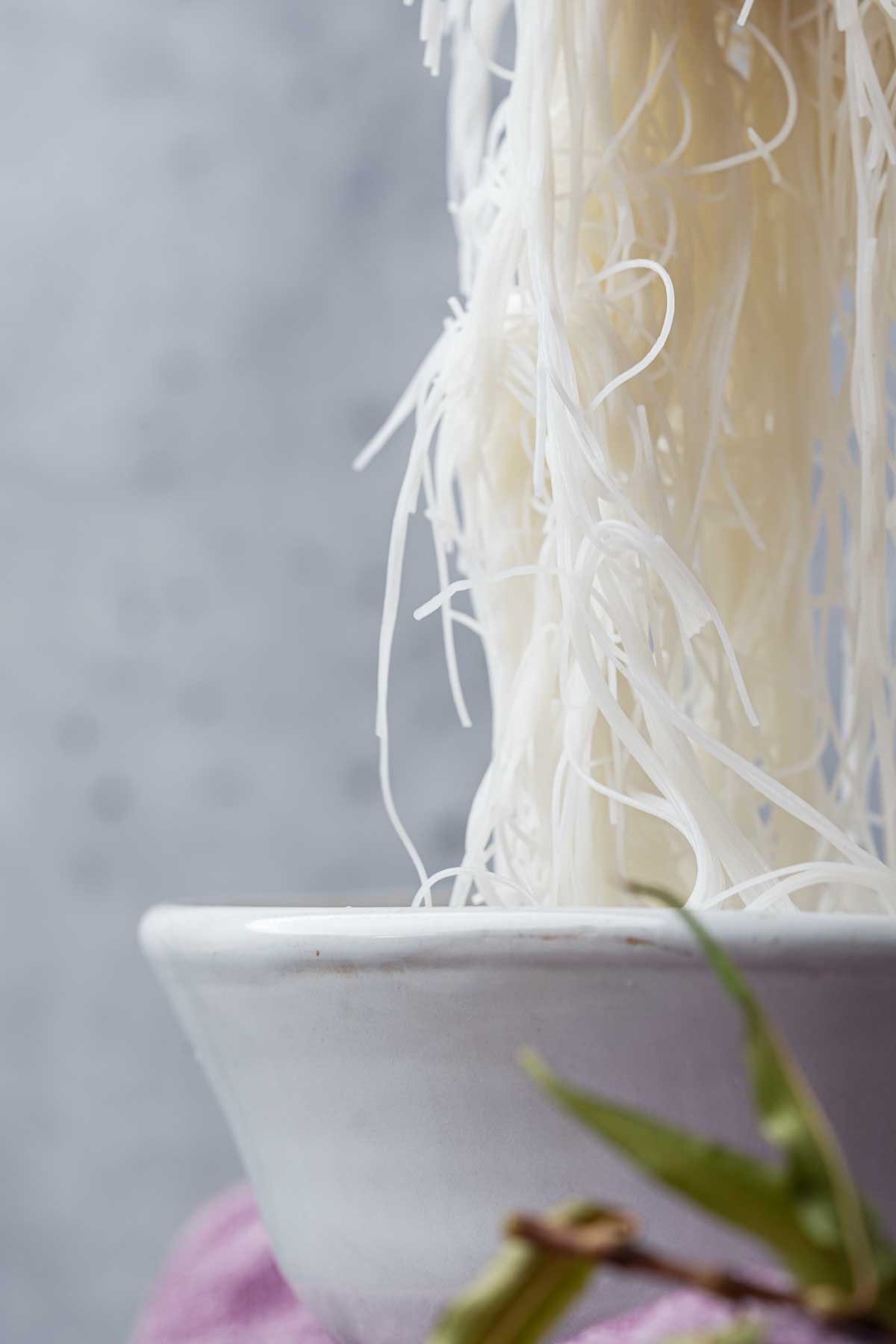
Step One
Soften your noods:
Submerge the dried rice vermicelli noodles in warm water until they become tender. Drain and set them aside.

Step Two
Marinade your tofu:
In a small bowl, combine minced garlic, sugar, and tamari (or soy sauce) to craft a flavorful marinade for the tofu. Thoroughly coat the tofu strips with this mixture and set them aside.

Step Three
Veggie Overload:
Shred the lettuce, and finely chop fresh mint, Thai basil, and chives. Slice bird's eye chilies. Rinse the beansprouts in a colander under cold running water and let them drain dry. Chop up your Vietnamese coriander leaves if you are using them. Mix together with a tiny bit of salt.
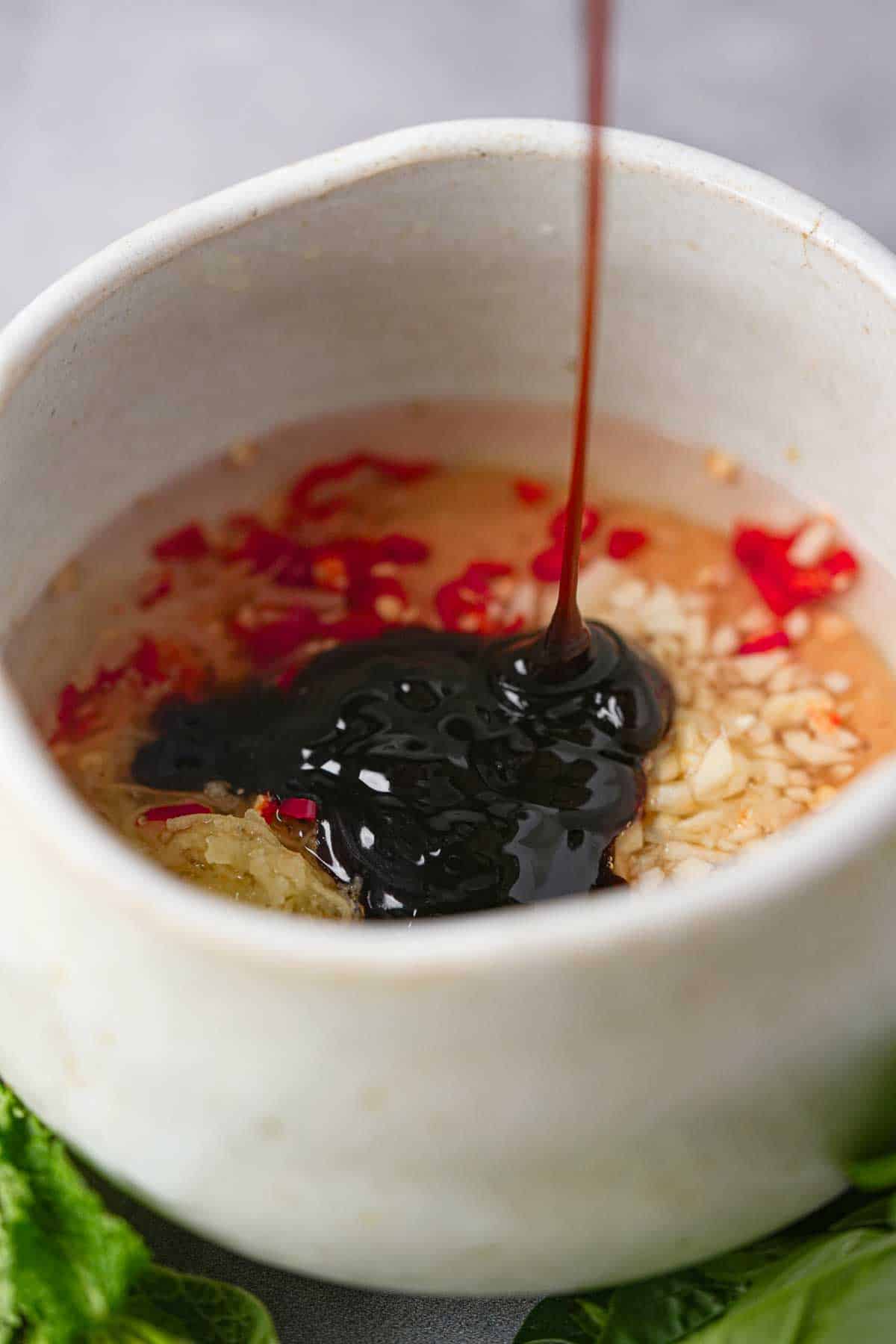
Step Four
Whip Up Dipping Sauce:
In a bowl, blend thinly sliced bird’s eye chilies, grated ginger, minced garlic, hoisin sauce, peanut butter, and water until a smooth, luscious dipping sauce forms, using a fork to mix well. If you want a thinner Vietnamese peanut sauce, you can stir in a little vegetarian fish sauce or water.
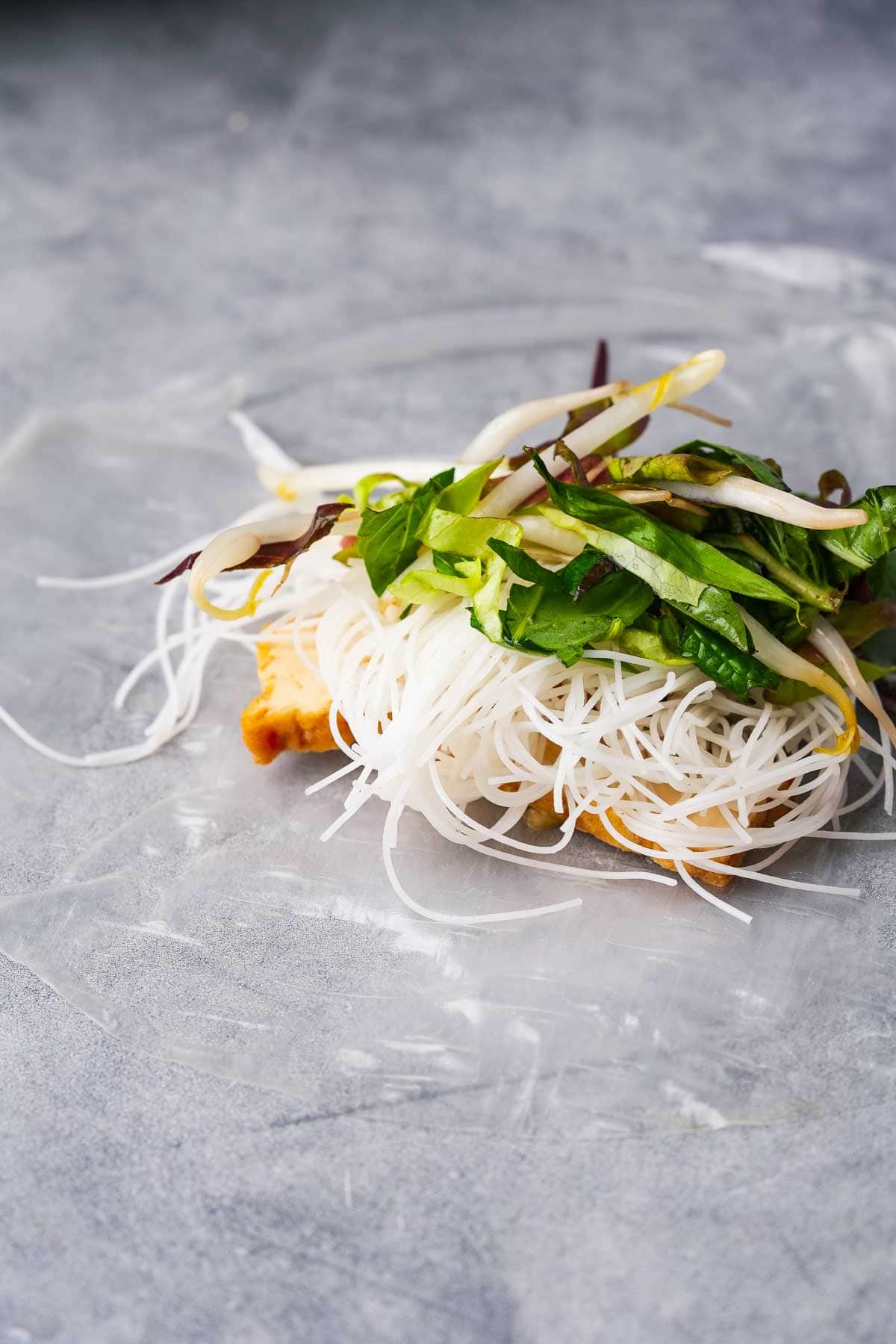
Step Five
Be a professional rapper:
Fill a spacious bowl with warm water. Immerse 2-3 rice paper wrappers in the water for a few seconds each. Then, place the moistened rice paper on a clean surface.
Lay a portion of soaked thin rice noodles, marinated tofu, and the mixed herbs onto the softened rice paper.
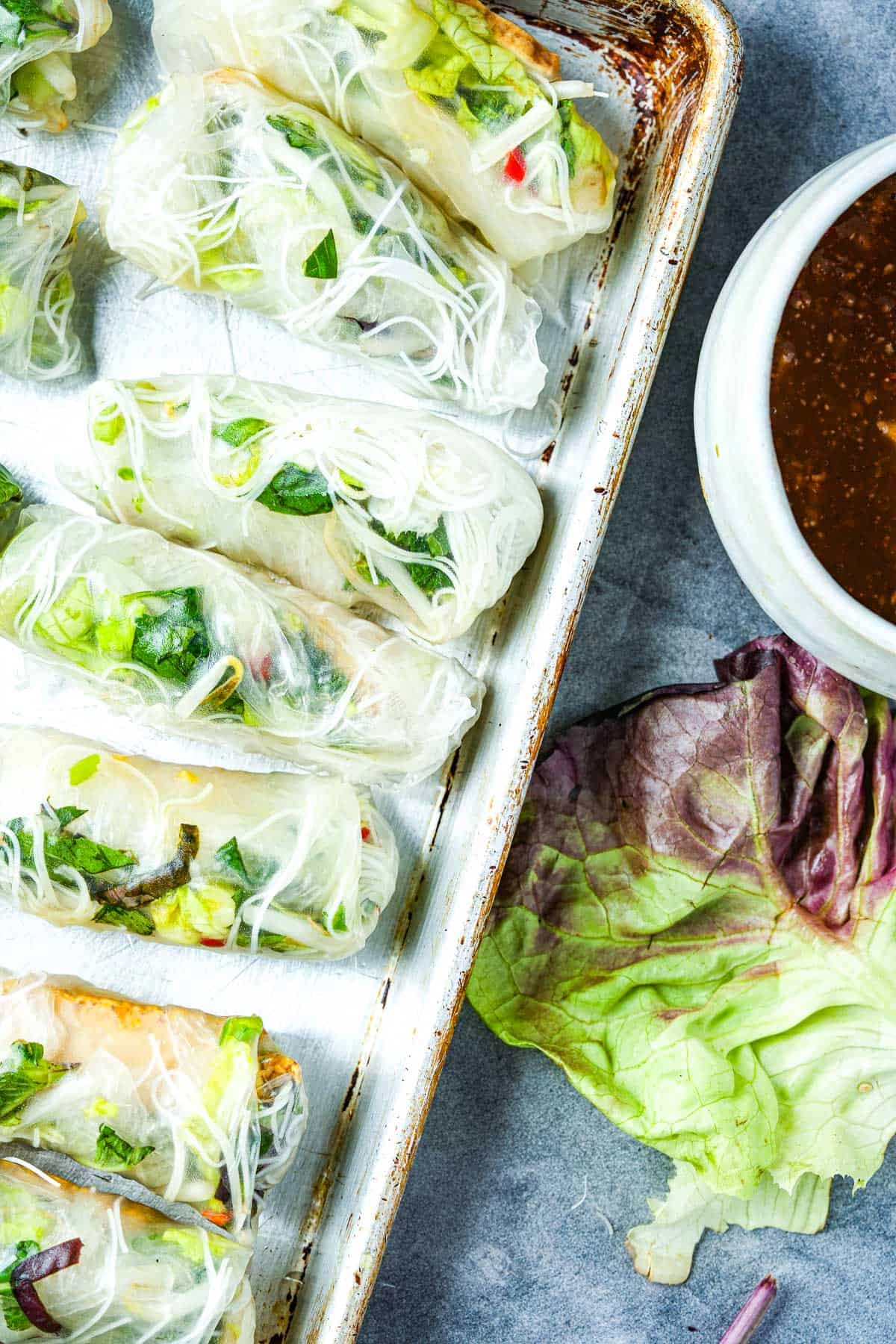
Step Six
Just roll with it:
Roll the rice paper tightly over the filling, ensuring the sides are neatly tucked in. Repeat this process with the remaining ingredients and rice paper wrappers.

Step Seven
A sprinkle of love:
Lay the Goi Cuon onto an attractive serving dish with a tiny bit of space between them to prevent them from sticking. Serve with the prepared dipping sauce and garnish with fresh mint leaves, Thai basil, sliced chives, bird’s eye chilies, and a sprinkling of toasted sesame seeds. Serve with a big juicy ol' tofu banh mi, or tall glass of Thai tea, why dont'cha?
If you want some extra heat, you can serve them with some pickled green chilies or spicy marinated cucumbers.
💡Serving Ideas
Goi Cuon is just begging to be part of the party!
After savoring these fresh spring rolls as an appetizer, why not indulge in the flavors of Tom Yum Fried Rice, turmeric rice, or nasi minyak, accompanied by crispy Tofu Sisig? If you want something meaty that’s completely vegetarian, you might want to hit up Tofu Katsu, seitan bulgogi, or Vegan Fried Chicken, drizzled with Nam Prik Pao.
To perk these salad rolls up with something tangy, pickled burdock, pickled amla, carrot pickles, or kimchi can all increase the umami.
If you're up for a full-on feast, dive into a big bowl of Bami Goreng, Mi Goreng, Mee Rebus, Ketoprak, or curried Burmese noodles.
And if you want a lighter veggie-centered meal, consider serving goi cuon with dishes like Asinan Sayur, Ensaladang Talong, Miso-Glazed Eggplant, or Urap Sayur Salad to add some green goodness to your meal.

👉Top tips
- Noodle Soaking Precision: Soak your rice vermicelli noodles just until they're soft but not overly mushy. Proper timing ensures the ideal texture in your rolls. NEVER, ever boil ‘em!
- Marinating Mastery: Give the tofu time to marinate fully in the garlic, sugar, and tamari. If you have time and want to let them sit in the marinade overnight in a container, that’s awesome.
- Wrapper Handling: Be cautious not to over-soak the rice paper wrappers. Just a few seconds in warm water is enough to soften them for rolling without making them too fragile.
- Rolling Precision: When rolling, start by folding the sides over the filling, then roll tightly. Keeping the rolls compact and secure prevents ingredients from escaping. If the wrapper just slightly sticks to the surface you are working on, it makes it easier to stretch and wrap tightly around the filling.
- No sticking: When you serve yourBanh Trang Cuon, ensure the rolls are not touching so they don't stick to one another. If you aren’t going to serve them right away, be sure to store them in a very lightly oiled container, and again, make sure they don’t touch each other while still tacky.
🤷♀️FAQ
If you have an un-textured work surface, like a stainless steel counter, lay a clean, damp kitchen towel over your work surface, and assemble the rolls on it to prevent sticking.
Absolutely, but ensure you store them in a lightly oiled airtight container in the refrigerator with a tiny bit of space between each roll so that they don’t merge into one terrible mass.
Certainly, you can adjust the heat level of the dipping sauce by using fewer bird's eye chilies or leaving them out altogether.
You can also use my Vietnamese peanut sauce recipe, which really isn't spicy at all.
To conclude your feast on a sweet note, relish the luscious flavors of Vietnamese Banh Flan, Chè Khoai Môn, Chè Ba Màu, Tupig, Martabak Manis, or Bubur Cha Cha.
✌️My faves to serve with banh trang cuon:

Banh Trang Cuon (Vegan Vietnamese Goi Cuon Spring Rolls)
Equipment
- Small bowl for tofu marinade
Ingredients
Tofu and noodles:
- 1.4 oz rice vermicelli (40 g.)
- 7 oz fried tofu cut into strips
- 1 clove garlic minced
- ½ teaspoon sugar
- 1 teaspoon tamari or soy sauce
Veggies and Rice Paper
- 1 ½ cup shredded lettuce washed and dried (Boston Bibb or red leaf are best)
- ½ cup fresh mint chopped
- ½ cup Thai basil leaves
- ¼ cup chives thinly sliced
- 3 bird’s eye chili thinly sliced (optional)
- 1 cup bean sprouts
- 6 Vietnamese coriander leaves rough chopped (optional)
- ¼ teaspoon salt
Dipping Sauce:
- 2 bird’s eye chilies thinly sliced
- ½ teaspoon ginger grated
- 1 clove garlic minced
- ¼ cup hoisin sauce
- 3 tablespoons
smooth peanut butter
- ¼ cup water
To form and garnish
- 12 large size rice paper wrappers
- Fresh mint leaves
- Thai basil
- Chives thinly sliced
- Bird’s eye chilies thinly sliced
- Toasted sesame seeds
Instructions
- Soak the dried rice vermicelli noodles in warm water until they're soft. Drain and set aside.
- In a small bowl, mix the minced garlic, sugar, and tamari (or soy sauce) to create a marinade for the tofu. Coat the tofu strips evenly with the marinade and set aside.
- Prepare the vegetables: shred the lettuce, and chop the fresh mint, Thai basil, and chives. Thinly slice the bird's eye chilies. Rinse the bean sprouts under cold running water and let them dry in a colander. Chop up your Vietnamese coriander leaves if you are uisng them. Mix all the herbs and veggies together along with the salt.
- For the dipping sauce, combine the thinly sliced bird’s eye chilies, grated ginger, minced garlic, hoisin sauce, peanut butter, and water in a bowl. Using the tines of a fork, mix well until smooth.
- Fill a large bowl with warm water. Working with 2-3 pieces of rice paper, dip each rice paper wrapper in the water for a few seconds. Place the wet rice papers on a clean work surface spread out so each one doesn't stick to the others.
- Place a small amount of the soaked rice vermicelli noodles, marinated tofu, and mixed herbs on each softened rice paper.
- Carefully roll the rice paper over the filling, tucking in the sides to enclose the ingredients tightly. Repeat with the remaining ingredients and rice paper wrappers.
- Serve the goi cuon with the prepared dipping sauce and garnish with fresh mint leaves, Thai basil, sliced chives, bird’s eye chilies, and toasted sesame seeds.
Notes

Enter your email & I'll send it to your inbox. Plus, get great new recipes from me every week!
By submitting this form, you consent to receive emails from Cinnamon Snail.

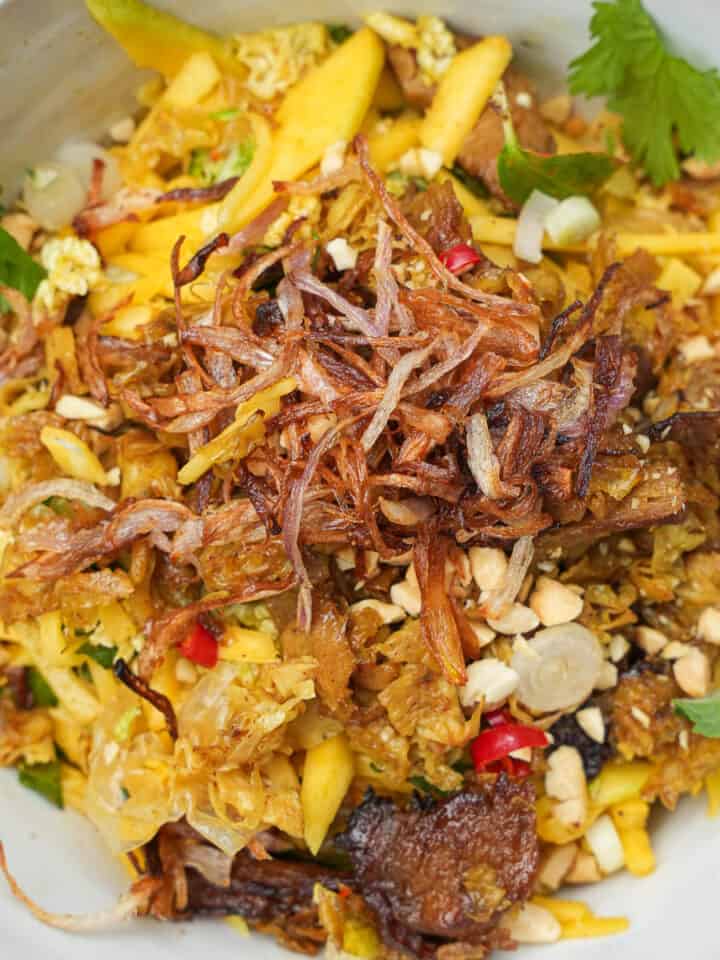
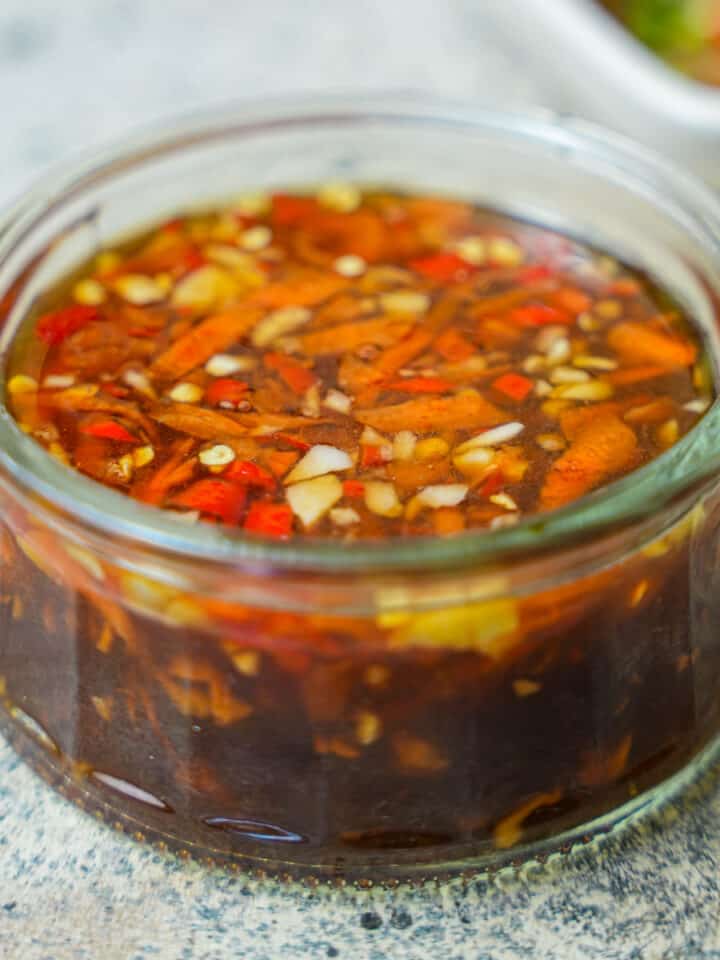
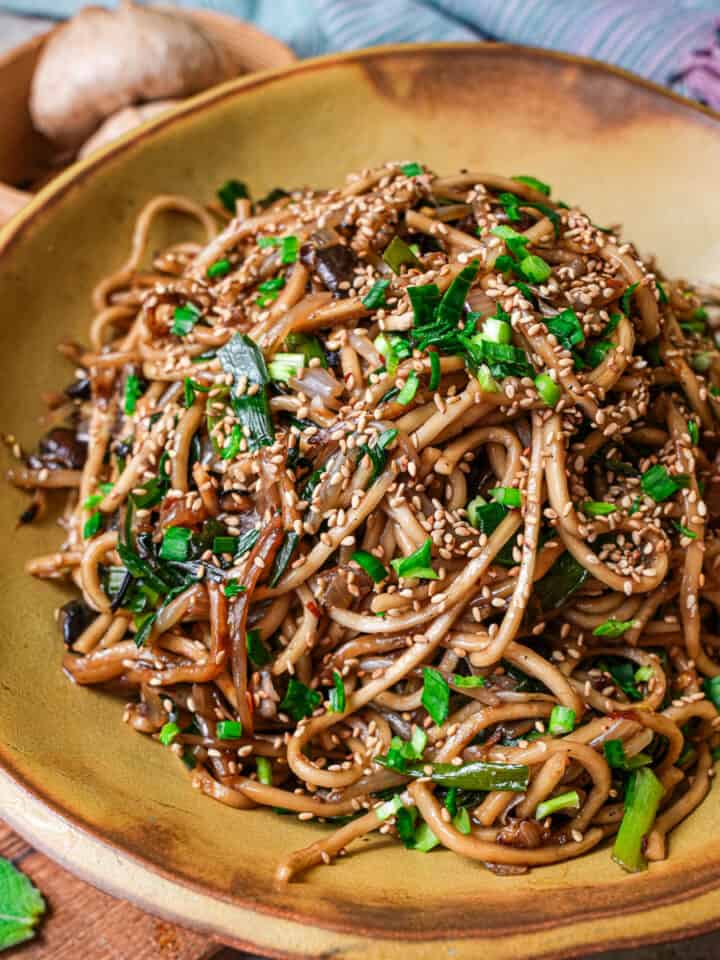
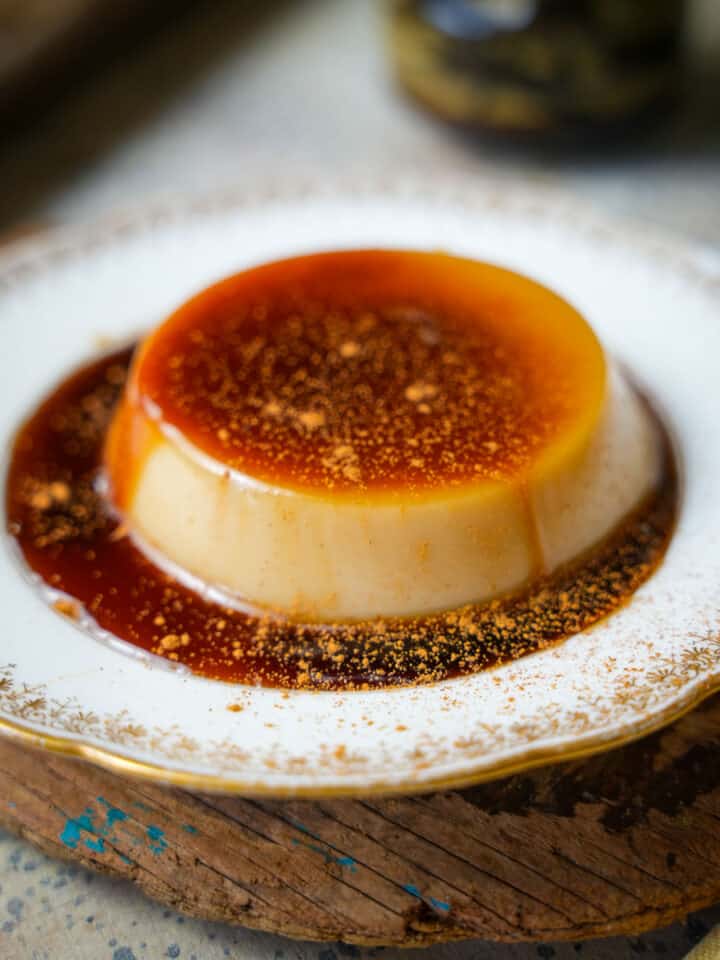





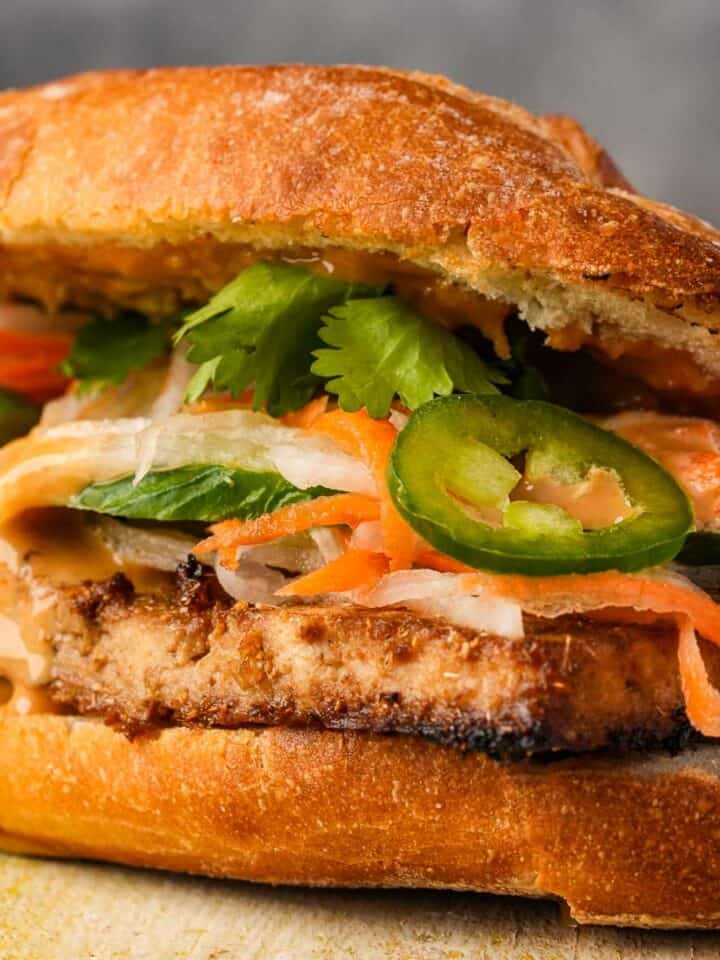
Leave a Reply